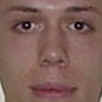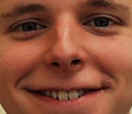Elgenfaces created from class images (non_smiling)
![]()
![]()
![]()
![]()
![]()
![]()
![]() 7 eigenfaces
7 eigenfaces
![]() average face
average face
There are total 22 faces in the folder class_smiling_croped (15 males, 9 females)
1. 19
recognized correctly, 3 incorrectly
2. average
position when the program fail to recognize = (1+6+3) / 3 = 3.3
3. 10
faces (7 males, 3 females) have the same gender as at least 2 of of 2nd, 3rd,
4th faces
46% matching for male, 66% for female
5. The eigenfaces computed from the different set of users gives more divers coefficients when projecting users.
More variance in the coefficients helps identifying users better.
Elgenfaces created from undergraduate images
![]()
![]()
![]()
![]()
![]()
![]()
![]()
![]()
![]()
![]()
![]()
![]()
![]()
![]()
![]()
![]()
![]()
![]()
![]()
![]() 20eigenfaces
20eigenfaces
![]() average face
average face
Total 18 students who are in the class undergraduate set
2 out of 18 students recognized (11%), 6 out of 18 are among top 5 of closest face (33%)
3 out of 18 studetns recognized (17%), 7 out of 18 are among to 5 of closest matching faces (39%)
4 out of 18 studetns recognized (22%), 7 out of 18 are among to 5 of closest matching faces (39%)
4 out of 18 studetns recognized (22%), 7 out of 18 are among to 5 of closest matching faces (39%)
The same recognition rate as using 15 eigenfaces.
1.see results
2. 15 eigenfaces
You can see the "best" matching among the wrong recognitions ( with the lowest mse)
| seitz |

galen |
| ranking 0: margaux
|
ranking0: alissah
|
| ranking 1: tshail
|
ranking 1:melissa
|
| ranking 3: tanderl
|
ranking 3: tamoore
|
It's hard to tell from these images why they are ranked closed to the target users (seitz, and galen).
But they have are close to the users in the face space.
3. The training photos and recognition photos were taken under pretty much the same condition (similar lighting, same camera, etc) .
So program has higher recognition rate. In the second procedure, the training photo (ugrad_cropped) and the recognition photos (non_smaile) were taken at different date and
possibly under very different lighting condition. Those factors results in the same user having large difference in face projections. That's probably why the recognition rate turn out
pretty low.
4.Increasing the number of eigenfaces seem to help raising the recognition rate, but overall the performance is poor. 15 works best. Using more than 15 eigenfaces did not give me better results.
TOP ROW: cropped by this project
 |
 |
 |
 |
 |
 |
 |
 |
 |
 |
 |
 |
 |
 |
 |
 |
 |
 |
 |
 |
BOTTOM ROW: pre-cropped
1. min_scale = 0.20 max_scale = 0.35 step = 0.05
2. 9 out of 10 looks correct. One cropped to a student's shoulder rather than her face.
3. The program was fooled into thinking a non-face region is a face in the third cropped image.
face detection
comparison: results from using two different error function
| error = mse * distance(face, averageFace) / (face varience) | error = mse * distance(face, averageFace) / sqrt(face varience) |

2 out of 4 detected Min_scale = 0.25 Max_scale= 0.3 step = 0.025 |

3 out of 4 detected Min_scale = 0.25 Max_scale= 0.3 step = 0.025 |

3 out of 5 faces detected Min_scale = 0.9 Max_scale = 1.0 step = 0.05 |

2 out of 5 faces detected Min_scale = 0.9 Max_scale = 1.0 step = 0.05 |
I tried several error functions, but how well each function works depends on what kind of photos is being processed. I wasn't able to find a function that work universally well.
error = mse * distance(face, averageFace) / (face varience) works best for photos with faces taken under similar situations as the training data. But it still gets fooled by
low texture areas. If the algorithm can do some color detection in addition to PCA, then the program can get rid of a lot of the low-texture area, such as the green wall and white curtian
in the second image.